| “ | Criminals are made, not born. | ” |
— Kehoe's message left for authorities on his farm fence
| ||
Andrew Philip Kehoe was an American mass murderer and school bomber responsible for the 1927 Bath School massacre, which killed 45 people (including himself) and left 58 others wounded.
It is currently the deadliest massacre on an American school in United States history.
Background[]
Born on February 1, 1872, Kehoe was one of thirteen children, with his parents coming from western New York. While he was five, Kehoe's mother passed away and his father remarried; however, Kehoe didn't get along well with his stepmother and both were known for their arguments. While Kehoe was fourteen, his stepmother caught fire when an activated stove exploded right in front of her. Kehoe watched her burn for a few minutes before putting out the flames, but it was too late, for the sustained injuries were fatal. Though it has never been confirmed, neighbors believe Kehoe might be behind the stove explosion, as it was caused by a malfunction. Kehoe later attended Tecumseh High School and, after graduating, became a student at Michigan State University (then called Michigan State College). There, he met his future wife, Ellen "Nellie" Price. In 1911, Kehoe suffered a severe head injury after a fall, and drifted in and out of a coma for a course of two months. After recovering, Kehoe returned to Michigan and married Ellen. Since Ellen was the member of a wealthy family, she and Kehoe were able to purchase an 185-acre farm outside the village of Bath Township.
Kehoe was a strange man, always quick to help others but also prone to angered criticizing whenever his ways aren't met, intelligent and articulate but also impatient. He was also known for his neat and clean habits, as well as his affinity for tinkering with machinery. Quite disturbingly, Kehoe displayed animal cruelty numerous times, once beating a horse to death. Whether or not these personality traits are positively attributed to his 1911 head injury and subsequent coma is currently unknown. Establishing a reputation for his thriftiness, Kehoe became treasurer for the Bath Consolidated School board because of this. Campaigning for lower taxes, he admitted this was because the taxes were causing him financial hardship. Eventually, Ellen fell chronically ill with tuberculosis and began visiting the local hospital frequently, thrusting Kehoe further into debt. Kehoe finally stopped paying his mortgage and began blaming the Bath Consolidated School for all of his troubles. He formulated a revenge scheme and began planting explosives around Bath School for months without being noticed.
The Bath School Bombing[]
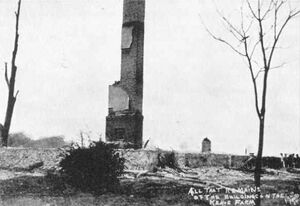
The remains of Kehoe's house after the fire-bombing.
Finally, on May 18, 1927, Kehoe snapped and murdered Ellen by bludgeoning her head with an unspecified heavy object. He then set the barn on fire using homemade "firebombs", so as to leave nothing for Ellen's relatives to inherit, before leaving off for Bath School in his pickup truck. People noticed the farm explosion and began rushing to the scene to aid any potential victims. The explosion was so large that some of the debris even landed on a neighboring farm; no one was injured. Kehoe pulled up in his truck and casually told the responders, "Boys, you're my friends. You better get out of here. You better head down to the school." before driving off.
Kehoe arrived at the school, upon which he detonated the explosives he set around the school, setting off two explosions that obliterated the structure, mostly the northwest wing, killing dozens of children and two teachers. Just like the farm explosion, people flocked around the school ruins to help survivors out of the wreckage. Less than half an hour later, Kehoe drove up to the scene, having loaded the back of his truck with dynamite and crude shrapnel. Calling over Superintendent Emory Huyck, Kehoe told him that he was the perpetrator of the bombings before picking up a Winchester rifle, firing a single shot into the dynamite, and blowing the truck up, killing himself, Huyck, and four other bystanders, and also wounding many more.
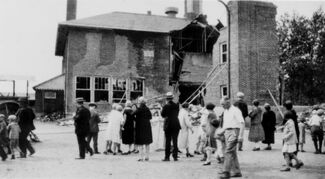
The rear view of Bath School after the bombings.
Even after Kehoe's suicide attack did the town continue to get attacked by him: Kehoe's Pyrotol continued to explode periodically, the original explosions left rows of parked cars ablaze, and people actually began to faint from the bloody carnage. The police and fire departments arrived and were met with a terrifying scene that witnesses have described as "a battle zone from a world war". A woman living near the Bath School soon found Kehoe's remains, with them his driver's license and papers from a bankbook from the Lilley State Bank of Tecumseh. As authorities cleared the wreckage of the school away in search of more bodies and survivors, they discovered many pounds of undetonated explosives still in what was left of the structure. Police were able to dismantle all of them and found that Kehoe planned to kill hundreds: had the undetonated explosives gone off, the death toll would've been sitting in those numbers. The following day, authorities came to what remained of the Kehoe barn and found Ellen's corpse, as well as a message left for them, which read: "CRIMINALS ARE MADE, NOT BORN."
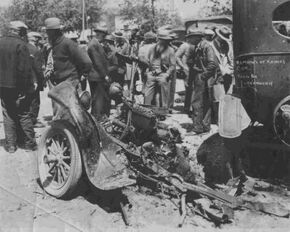
The remains of Kehoe's truck after the suicide bombing.
News of the school bombing quickly spread all over the world, with many newspaper headlines announcing the horrific event. People of the Bath community were greatly devastated from the tragedy, with nearly everyone having lost a relative or colleague. The community was also affected economically due to the construction of a new school. Seven decades later, a museum commemorating the victims of the bombing was established, with many civilians turning in items from the tragedy as donations for the museum's construction. As for the Bath Consolidated School, it had been torn down completely and replaced with another school building, which has also been torn down since. The location of the school has now been turned into a park with a bronze memorial plaque for those killed from the bombing at its center. The production and use of pyrotol also began to dwindle after the bombings, though it is unknown if the bombings were the cause of this decrease, as military surplus powder supplies had already been running out at the time. One way or the other, pyrotol eventually went out of use completely after the end of World War I. Despite the fact that many bomb explosions have happened in schools in the United States since then, none have had such massive casualties and damage as the Bath bombings.
Modus Operandi[]
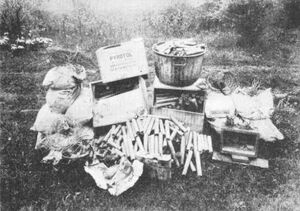
The explosives recovered from underneath the Bath School.
Kehoe killed his wife by beating her to death before setting his barn on fire with her body still inside, presumably to cover his tracks. When he attacked the Bath School, he used dynamite and hundreds of pounds of pyrotol, an inexpensive post-World War I explosive, which he spent months planting. These explosives were triggered to detonate with a handheld detonator. He also utilized a Winchester rifle, though he didn't use it against any victims; instead, he used it to detonate explosives during his suicide attack.
Known Victims[]
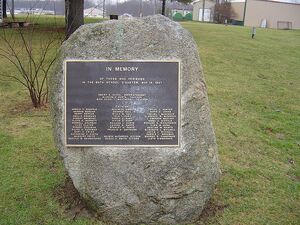
The plaque at the entrance of the Bath School Memorial Park.
- Unspecified date in 1886: His unnamed stepmother (possibly; burned from an explosion caused by a stove malfunction)
- May 16-18, 1927: The Bath School disaster:
Fatalities
- May 16-18: Ellen Kehoe, 52 (his wife; bludgeoned with an unknown heavy object, then set on fire post-mortem)
- May 18:
- Bath Consolidated School
- The first explosion:
- Arnold Bauerle, 8
- Henry Bergan, 14
- Herman Bergan, 11
- Emilie Bromundt, 11
- Robert Bromundt, 12
- Floyd Burnett, 12
- Russell Chapman, 8
- F. Robert Cochran, 8
- Ralph Cushman, 7
- Earl Ewing, 11
- Katherine Foote, 10
- Marjorie Fritz, 9
- Carlyle Geisenhaver, 9
- George Hall, Jr., 8
- Willa Hall, 11
- Lola Hart, 12
- Percy Hart, 11
- Vivian Hart, 8
- Blanche Harte, 30 (teacher)
- Gailand Harte, 12
- LaVere Harte, 9
- Stanley Harte, 12
- Francis Hoeppner, 13
- Cecilia Hunter, 13
- Doris Johns, 8
- Thelma MacDonald, 8
- Clarence McFarren, 13
- J. Emerson Medcoff, 8
- Emma Nickols, 13
- Richard Richardson, 12
- Elsie Robb, 12
- Pauline Shirts, 10
- Hazel Weatherby, 21 (teacher)
- Elizabeth Witchell, 10
- Lucile Witchell, 9
- Harold Woodman, 8
- George Zimmerman, 10
- Lloyd Zimmerman, 12
- Kehoe's suicide bombing:
- Emory Huyck, 33 (school superintendent)
- G. Cleo Claton, 8 (Bath School student)
- Nelson McFarren, 74 (retired farmer)
- Glenn Smith, 33 (postmaster)
- Beatrice P. Gibbs, 10 (survived the bombings, but later died of her injuries)
- The first explosion:
- Bath Consolidated School
Injuries
- Lloyd Babcock
- Norris Babcock
- Vera Babcock
- Ruth Barnes
- Anna Braska
- Gertrude Burnett
- Earl Chapman
- Willis Cressman
- Wilma Cressman
- Arthur Delau
- Ida Delau
- Marcia Avis Detluff
- Bob Dickinson
- Adabelle Dolton
- Josephine England
- Iva Eschtruth
- Marion Eschtruth
- Raymond Eschtruth
- James Foster
- Althea Frederick
- Francis Fritz
- Richard Fritz
- Dorothy Fulton
- Kenneth Geisenhaver
- Eva Gubbins
- Leona Gutekunst
- Perry Hart
- Helen Hobert
- Ralph Hobert
- Carlton Hollister
- Donald Huffman
- June Huffman
- Florence Hunter
- Pauline Johns
- Lester King
- Florence Komm
- Helen Komm
- Lee Mast
- Nina Matson
- Pauline McCoy
- Willis McCoy
- Harold McKenzie
- Thelma Medcoff
- Ottelia Nichols
- Ruth Nichols
- Mrs. Joe Perrone
- Earl Proctor
- Ralph Proctor
- Lee Reasoner
- Lillian Reed
- Martha Richardson
- Virginia Richardson
- Oral Riker
- Jack Rounds
- Norman Sage
- Ivan Seeley
- Gail Stebleton
- Steve Stavinske
- Lester Stowells
- Ava Sweet
- Dean Norman Sweet
- Lillian Wildt
- Ardis Wilson
- Kenneth Witchell
- Cecelia Zavistoski
Notes[]
- It is Kehoe's final suicide attack that marks the first suicide bombing, as well as the first suicide car bombing, and the first school bombing in world history.
- When the Sandy Hook Elementary School massacre occurred on December 14, 2012, the media briefly compared it to Kehoe's bombing. They are similar in several aspects; both killed dozens of schoolchildren and adults at a primary school, both killed a relative of theirs prior to the massacres (Kehoe killed his wife, Adam Lanza killed his mother), and both committed suicide at the end of their attacks.
- Eric Harris and Dylan Klebold's original plan for the Columbine High School massacre also resembles Kehoe's school attack: it would start with a diversionary explosion, followed by the bombing of the school, then the detonation of car bombs. The original plan failed, however, when Harris and Klebold's bombs only fizzled and partially detonated in some cases, with no loss of life due to the explosions.
On Criminal Minds[]
While Kehoe was never directly mentioned or referenced on the show (or its spin-offs), he appears to have been an inspiration for the following unsubs:
- Season Seven
- Randy Slade ("Painless") - Both were school bombers who were known for their intelligence, attacked the school they were involved with (Kehoe was the school's treasurer while Slade was a student), used both explosives and a firearm (though the latter was only used in Kehoe's suicide), their massacres left over a dozen people dead and several more dozen injured, committed suicide with their bombs, and their massacres had media-given nicknames and spread lots of infamy that lasted for years afterwards.
- Season Ten
- James Burke ("Hero Worship") - Both were narcissistic "collector"-type ("injustice" in Kehoe's case, "wound" in Burke's) murderers, serial bombers, and arsonists with city school board positions they later lost, targeted their facilities of employment and assignment out of revenge, started their spree with an arson, killed at least one victim in a school bombing, targeted the entire cities by planting additional bombs (including one in a car), and were stopped in their attempted bombings when those bombs were diffused.
On Suspect Behavior[]
- Season One
- William Meeks ("Here is the Fire") - Both were serial bombers, school bombers, and mass murderers who lost their wives, were religious practicioners, killed a member of their families (Meeks killed one of his sons, Kehoe killed his wife), detonated bombs at schools they were connected to which killed numerous people (Meeks blew up his son's school, Kehoe blew up the school he was employed at), left messages for police to find at the scenes of the crimes, and attempted a murder-suicide (though only Kehoe succeeded).
